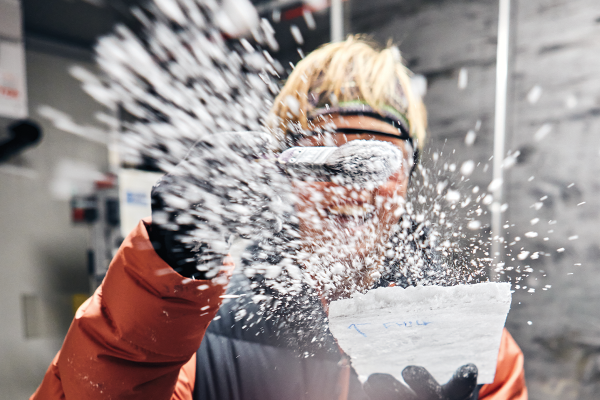We have an ice lab on campus. If you’re standing on the bridge over the Leith on Clyde St facing toward the harbour, you’ll see it: two blue shipping containers in a parking lot, set to a temperature of minus 8 degrees. The ice lab was set up around two years ago for students who’d previously had to complete a lot of their work bending over deep freezers to stop their subject matter from melting. There are four or five postgraduate students working in the lab, including Zoe MacClure, a Master’s Geology student studying ice. What she does is more complicated than that, of course, but if she were a Ken, her job would be Ice.
Zoe said that when she first was offered a postgraduate project working with ice, she was of the opinion that ice was “just all white and boring and there’s nothing going on there.” And we were tempted to end the interview there, but we didn’t. Like the unassuming exterior of the shipping container labs, “actually there’s a lot of really interesting processes going on and a lot of really beautiful things come out. I mean, as you can see,” she said, gesturing at the photos taken from inside the lab.
While many of her peers work with ice experimentally, Zoe’s is one of the few whose research is field-based. This, she said, is something she’s had a “bit of a love-hate relationship” with. She’s studying the stresses happening inside ice on the Tasman Glacier, so she can apply those findings to ice in the Antarctic. Obviously, this is a bit harder to access for samples. Ironically, she had the opportunity to spend three and a half weeks in Antarctica for a different project earlier this year to test ice core drilling equipment. It was well into the sub-forties while she was there: “Frostbite was a very real concern,” she said. But it’s nice and toasty in the ice lab’s puffer jackets. Mostly.
She’s taken three trips as part of her research to the Tasman Glacier, flying there by helicopter. The five-or-so people who travel there at a time set up camp on the ice with freezers and solar power battery generators: “The kitchen sink, really.” After they finish setting up camp, including a kitchen made out of ice, Zoe said that her supervisor treats them all to a martini on the glacier. “He’s got these plastic martini glasses and he’s taken the bottom of it and we use an ice screw… to make a hole [in the ice kitchen] and then our martini glasses can sit in a hole.”
Asked if she thought many students would realise that an ice lab was sitting in the middle of campus, Zoe laughed and said, “Honestly? Probably not. I think a lot of people know there’s work done with ice, but then probably just have not even considered how that would be possible - like collecting it in the field, keeping it in the freezer on the glacier and then the nerve wracking process of like driving home with a freezer going in the car and trying to keep everything cold enough… As soon as you cut the ice out, because it’s so warm in New Zealand” - compared to Antarctica, I guess? - “it’s just gonna melt, and we want to get it back here safely,” said Zoe. She described the paranoia of worrying there might be a power cut, rendering the entire field trip to collect the ice useless.
Next comes the analysis: spending long days wrapped up in a thick puffer jacket and gloves, using a band saw to slice the ice thin enough to see individual crystals. Ice crystals within the “S” squiggle shapes you can see pictured contain valuable data. This is where the “love-hate” comes in: “If you have a bunch of cold room days in a row it’s exhausting… you just don’t want to go back in there,” said Zoe. “You just feel drained for the rest of the day.”
Next time you complain about how cold your flat is, think of Zoe and her colleagues spending all day in a room colder than your fridge. For science, or something.



